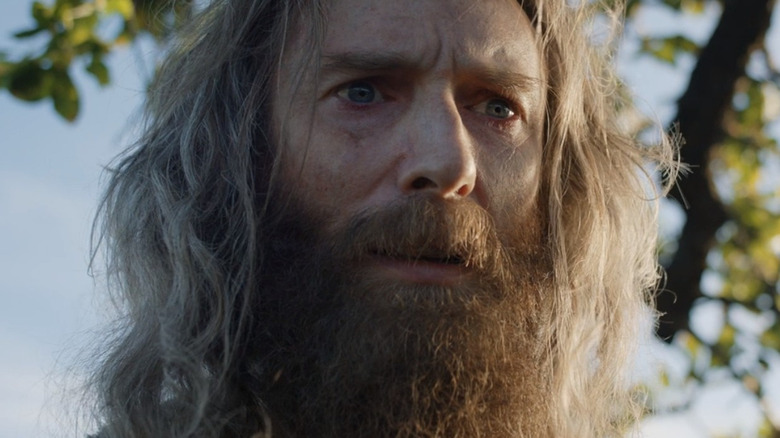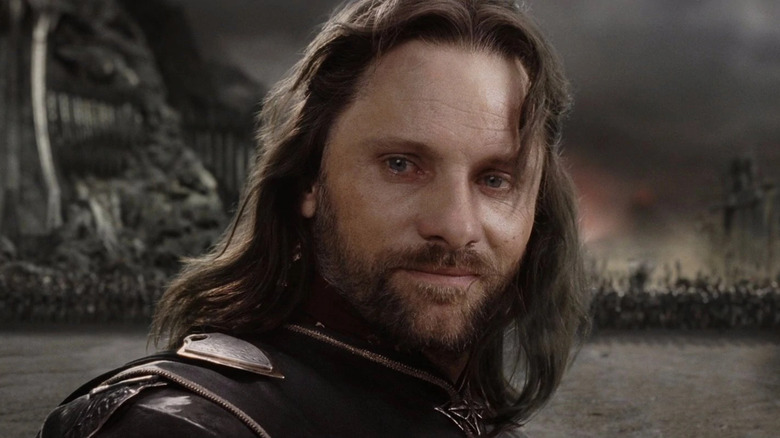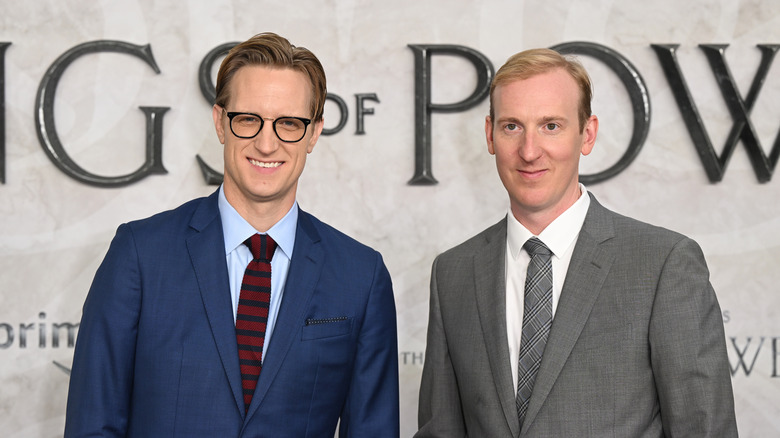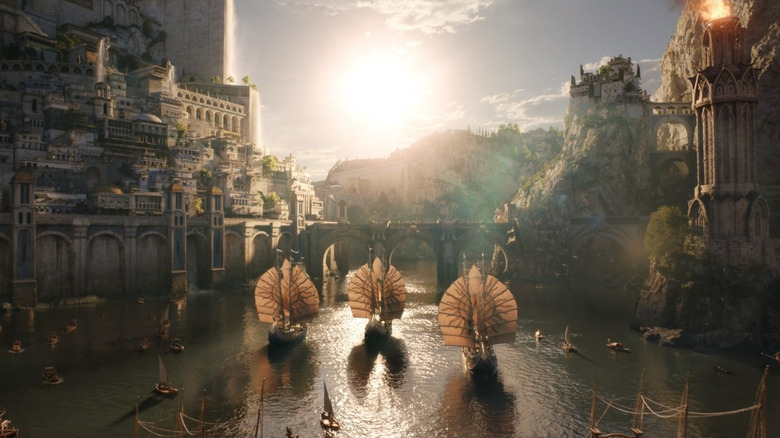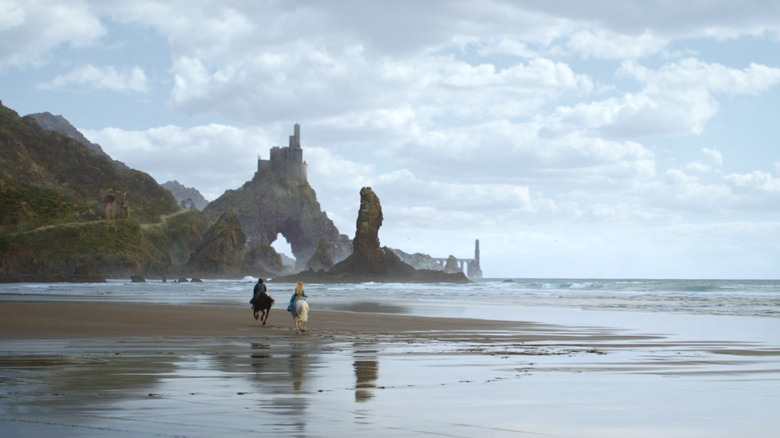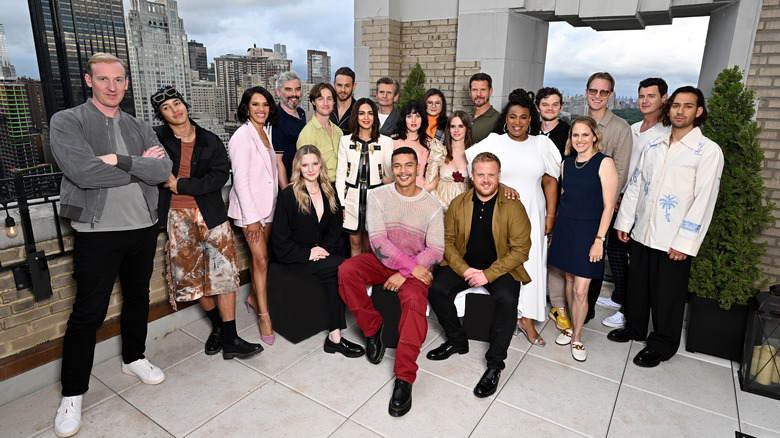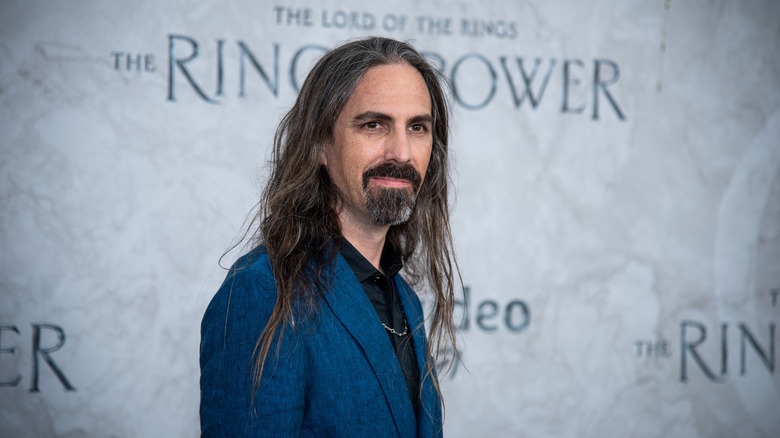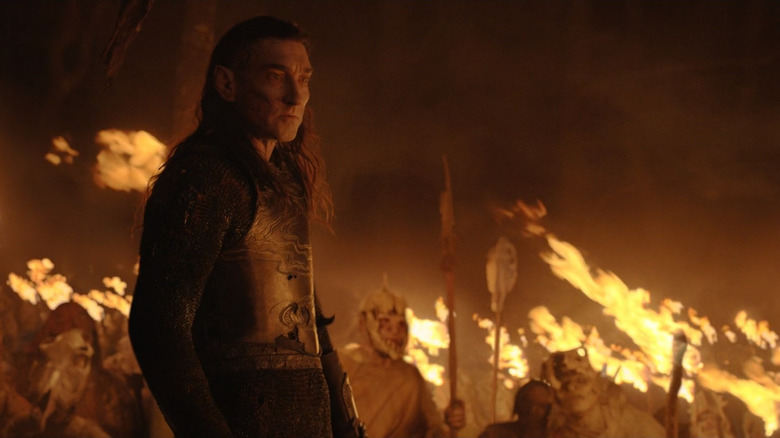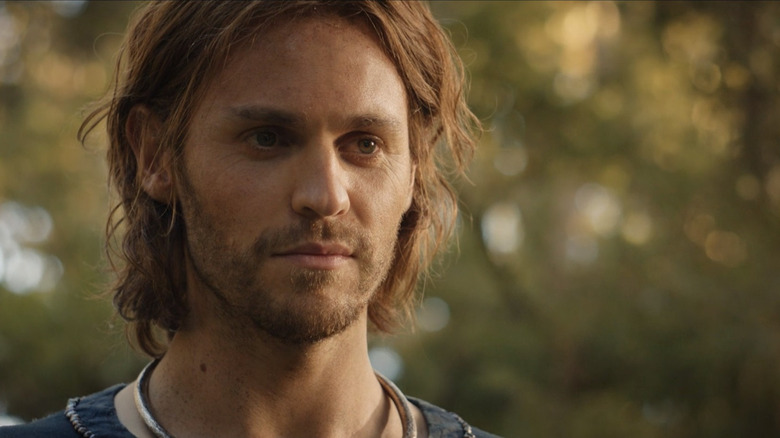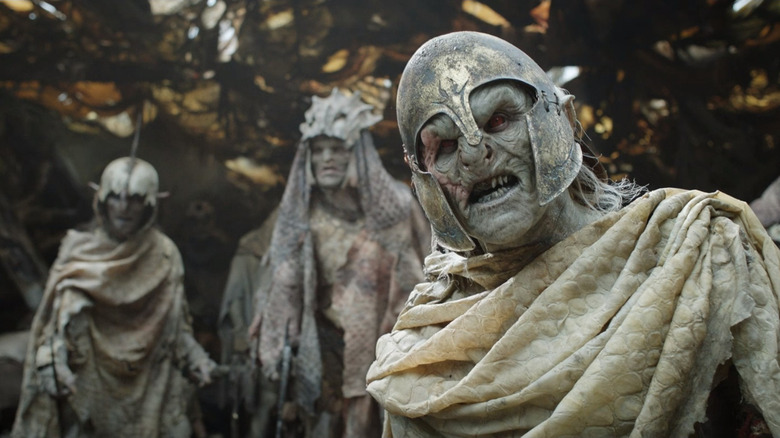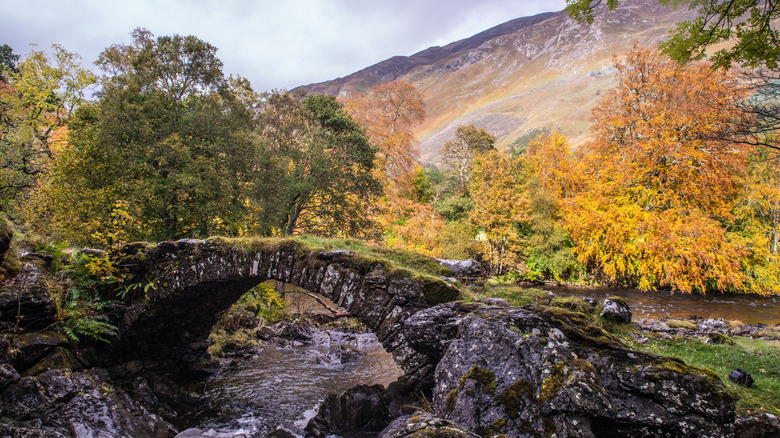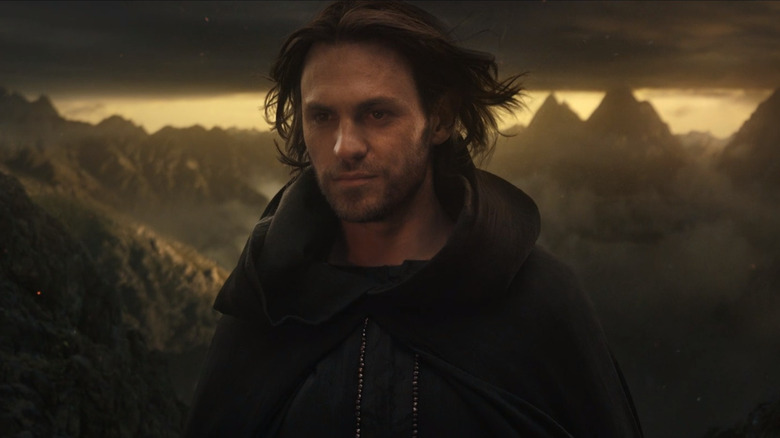Magical Facts The Lord Of The Rings: The Rings Of Power Fans Will Enjoy
In 1951, J. R. R. Tolkien wrote a letter to his publisher, Milton Waldman, in which he explained the origin and purpose of his imagined world. "I would draw some of the great tales in fullness," he wrote, "and leave many only placed in the scheme, and sketched. The cycles should be linked to a majestic whole, and yet leave scope for other minds and hands, wielding paint and music and drama."
Seventy years later, Amazon Studios released the first season of "The Lord of the Rings: The Rings of Power," the latest work of drama inspired by Tolkien's vast legendarium. Whatever the author himself might have thought of the current state of his world (in that same letter, he called his dream "absurd") it's hard to deny the show's success: Season 1 enjoyed a fresh Rotten Tomatoes critics' score and record-breaking viewership figures.
This chapter in the history of Middle-earth is long and complex, however, and the story of the show's development is as worth telling as that of the Second Age itself. From the early days to the future and everything in between, here's all that you need to know about "The Lord of the Rings: The Rings of Power."
Warning: Major spoilers for Season 1 of "The Rings of Power" follow.
A new adventure
The first seeds of "The Rings of Power" were sown back in 2017, when the Tolkien Estate informed a number of major studios that it was willing to accept proposals for a TV series based on "The Lord of the Rings." The various candidates pitched very different ideas to the estate — according to The Hollywood Reporter, HBO wanted to retell the story of the Third Age, including a full-blown remake of the "Lord of the Rings" trilogy. Meanwhile, Netflix suggested an MCU-style shared universe revolving around many different characters. "They took the Marvel approach," one insider told the publication, "and that completely freaked out the estate."
In the end, Amazon Studios won out. The company offered not a specific pitch, but a close working relationship with the Estate and a promise to preserve Tolkien's legacy. Of course, they also offered an absolute ton of money. Back in 2017, Deadline reported that Amazon had paid $250 million for the privilege of adapting Tolkien's work, although insiders later told The Hollywood Reporter that this was Netflix's bid; reportedly, Amazon actually offered significantly less than that. It appears that the Estate — which is currently headed by Tolkien's daughter-in-law Baillie and his grandsons Michael and Simon — turned down the chance for a bigger payout. Instead, they chose the studio that they believed would do right by the author's vision.
Enter the showrunners
After Amazon secured the rights to "The Lord of the Rings," the studio faced a new challenge: choosing a showrunner to oversee the series. According to The Hollywood Reporter, Amazon accepted pitches from such directors and writers as the Russo Brothers, who suggested an "Aragorn story," and Anthony McCarten, who apparently took a more "Shakespearean" approach to the Third Age.
Two of the candidates, however, saw a different path for Amazon's "Lord of the Rings" show. Relative Hollywood unknowns J.D. Payne and Patrick McKay met with Amazon executives and argued that the story should, in fact, take place in the Second Age of Middle-earth. Their one sentence pitch was thus: Tell the story of the prologue to Peter Jackson's "The Fellowship of the Ring" over the course of five seasons.
This was enough to catch Amazon's attention, but no studio is ever going to bet a billion dollars on two guys best known for an uncredited writing role on "Star Trek: Beyond." As such, the studio demanded over half a dozen more pitches by the pair over the next six months, including in-depth briefs of the planned narrative and meetings with members of Tolkien's family. A recommendation from Payne and McKay's former boss, J.J. Abrams, likely helped things along, but it was their unbridled passion for Middle-earth that finally won them the gig. "They had such a deep connection to the material that was there from the beginning," Amazon Studios head Jen Salke later told THR. "There was no education you could do for that; it was their natural organic interest."
Welcome to the Second Age
On March 7, 2019, Amazon Prime Video's "Rings of Power" Twitter account tweeted a link to a digital map of Middle-earth, accompanied by the caption: "Welcome to the Second Age."
Between the iconic tale of the Third Age and the beloved epics of the First Age, Tolkien's Second Age has long been something of a dark horse in the greater legendarium. The Second Age chiefly involves the forging of the 20 Rings of Power, the great war waged between Sauron and the Elves, the rise and fall of Númenor, and the War of the Last Alliance. It also contains some of the darkest material Tolkien ever wrote, marked by betrayal, greed, imperialism, heresy, and unending death and destruction.
Clearly, then, the Second Age is ripe for adaptation. Unfortunately, that hasn't been a particularly easy task for the show's creative team. Most of the narrative relating to this era can be found in "Akallabêth," the relatively short fourth part of "The Silmarillion," as well as the appendices of "The Lord of the Rings." Since Amazon only bought the rights to "The Hobbit" and "The Lord of the Rings," however, the studio is restricted to lifting material from the scant summaries of the age found in the appendices. Any gaps have been — and will have to be — filled by creative license devised by Payne and McKay ... for better or for worse.
Return to Middle-earth
Thanks entirely to the historic success of Peter Jackson's "Lord of the Rings" trilogy, Middle-earth has become practically synonymous with New Zealand. Jackson filmed all three of his movies in his home country and, in doing so, brought so much recognition to the islands that Air New Zealand uses "Rings"-themed safety videos and tourists can visit a massive recreation of the Hobbiton set.
It surprised nobody when Deadline reported in 2019 that Amazon's "Lord of the Rings" series would also be filmed in New Zealand. "We knew we needed to find somewhere majestic," Payne and McKay said at the time, "with pristine coasts, forests, and mountains, that also is a home to world-class sets, studios, and highly skilled and experienced craftspeople and other staff. And we're happy that we are now able to officially confirm New Zealand as our home for our series."
According to Yahoo!, about a third of the series was filmed across 38 locations in New Zealand's North and South Islands, while the rest was shot in a studio in Auckland. For example, filming locations site Atlas of Wonders claims that the Auckland-adjacent Anawhata Beach served as the coastline of Númenor, while the exterior of Khazad-dûm was filmed at Earnslaw Burn, north of Queenstown; meanwhile, the lake overlooked by the Ostirith watchtower is the South Island's Lake Quill, and the Harfoots begin their journey in Denize Bluffs, a farm near Piopio.
Casting the unknowns
When Amazon announced the cast of the new "Lord of the Rings" series you would have been entirely forgiven for wondering who any of those people were.
In a tradition carried over from Peter Jackson's trilogy, the majority of the show's stars were either unknowns, newcomers, or stage actors. Among the more prolific cast members were Sir Lenny Henry, a renowned British comedian; Nazanin Boniadi, who was particularly well-known for her activism; Joseph Mawle, who had previously appeared in "Game of Thrones," and Peter Mullan, who is perhaps best known for his roles in "Westworld" and "Ozark." By and large, these weren't exactly household names, and many of their co-stars had only a few screen credits to their names.
Payne and McKay's gamble has more than paid off, though. After only eight episodes, it's difficult to see anybody but these cast members in their roles — which is all the more remarkable for actors such as Morfydd Clark and Robert Aramayo, who are filling the shoes of the "Lord of the Rings" stars who came before them. If nothing else, the showrunners' knack for casting only makes the prospect of the next few seasons even more exciting, as new actors join the fold and more beloved Middle-earth characters are brought into the story.
The pandemic strikes
No film or TV production escaped the impact of COVID-19 in 2020, "The Rings of Power" included. As early as March of that year, it was announced that filming on the then-untitled Amazon series had been shut down due to the growing threat of the novel coronavirus. New Zealand took strict measures to prevent the virus' spread throughout the pandemic, including mandated self-isolation for overseas travelers and, at times, full lockdown restrictions.
At the time, the New Zealand Herald published a memo sent to the cast and crew explaining the reason for the shutdown. "We are doing this to minimise stress on the resources and infrastructures around us," it said, "by doing our part to reduce population density in our communities and daily activities, in efforts to help reduce the spread of the virus."
The effects of COVID on "The Rings of Power" seem to have outlasted the bulk of the pandemic, too. When Amazon Studios announced that production on Season 2 would be moving to the U.K., The Guardian reported that New Zealand's health policies had played some part in the decision. The country's pandemic restrictions have since been eased.
The music of Middle-earth
Howard Shore's score to the "Lord of the Rings" and "Hobbit" movies are as much a part of Middle-earth as the casts, the locations, or the stories themselves. While Shore returned to create the music for the opening titles of "The Rings of Power," Amazon Studios brought on a new composer for the rest of the score: Bear McCreary.
Known for his work on "Outlander," "The Walking Dead," and the "God of War" video games, McCreary was the perfect choice for the show's composer. "I'm a huge fan of the J.R.R. Tolkien books, of the legendarium, the mythology and the Peter Jackson films," he told Variety. "They were, in a way, at the nexus of my childhood and adulthood, the last films that took me away as a child. I watched those films over and over and over."
McCreary spent two months creating 15 new themes for the show, for characters from Galadriel to Sauron to Nori Brandyfoot, as well as locations such as Númenor and Valinor. "It was like writing a symphony," he explained. "I planned all this out so that when I could dive into the footage, I would have the pieces I needed in place." The music McCreary wrote was recorded by a 90-piece orchestra in London and a 40-voice choir in Vienna over just four days, and features world instruments such as the bagpipes, hardanger fiddles, and bodhrán drums — as well as guest vocals by cast members and singer-songwriter Fiona Apple.
As the icing on the cake for fans of Middle-earth music, the complete scores to each episode were then released on Amazon Music each week as the season aired.
Unfamiliar faces
Many of the characters who appear in "The Rings of Power" will be familiar to fans of the Middle-earth legendarium. Among the most famous, of course, are Galadriel, Elrond, and Sauron, but even less eminent characters such as Gil-galad, Celebrimbor, or Pharazôn play key roles in Tolkien's works.
Nevertheless, it takes more than a village to raise an epic, five-season series, and the creative team behind "The Rings of Power" devised a wide array of original characters for their story. The Harfoots, for example, have a basis in the text — in "The Fellowship of the Ring," Tolkien writes that the Harfoots "long lived in the foothills of the mountains" during the so-called "Wandering Days" — but every single one of them was concocted for the show. Adar, the ancient elf twisted by Morgoth, is based on an origin of the Orcs proposed by Tolkien but the character himself is a new invention. Even established families have been given new members for the show; Eärien, Isildur's sister, does not exist in Tolkien's books.
Of course, not all of the original characters in "The Rings of Power" are what they seem. Nobody knows who the Stranger is, and fans have speculated that Theo might turn out to be anyone from the Witch-king to a founder of Rohan. And that's to say nothing of the show's greatest mystery...
Who is Sauron?
One crucial character was conspicuously absent from the early stages of the "Rings of Power" marketing campaign, as well as the majority of the show's first season ... or so it seemed. The identity of Sauron was kept hidden from audiences — and even from the man who played him — for so long, in fact, that speculation over the big reveal ran rampant for many, many months.
One of the more grounded theories suggested that Daniel Weyman's Stranger might be the Dark Lord in amnesia mode, while some fans believed that Bridie Sisson's character, The Dweller, could have turned out to be Sauron. The show briefly toys with the idea of Adar being Sauron, to the point where Waldreg actually point blank asks him whether it's true or not.
The speculation doesn't end there, though. Some of the less grounded suggestions for Sauron's identity included Poppy Proudfellow, Galadriel, and the cow from the first episode. Of course, now that the finale has aired, we know that Sauron is none other than Halbrand, Galadriel's raft buddy and the not-king of the Southlands. Still, the Dark Lord is notorious for his shapeshifting abilities — so maybe that "Cowron" theory isn't dead in the water just yet.
Backlash
From early on, "The Rings of Power" was subjected to an online backlash that was overwhelming even by the standards of the modern-day internet.
Centered around the show's portrayal of female and non-white characters, the hate campaign against the show was characterized by racism, misogyny, and, ironically, the endless application of a Tolkien misquote. "The hardest part," Amazon Studios TV co-head Vernon Sanders told The Hollywood Reporter, "was for people on the cast who have had things related to them privately that are just harmful." This worsened to such an extent that, in September 2022, the series' official Twitter account posted a message of solidarity issued by the cast, stating that they stood against the "racism, threats, harassment, and abuse" that had been levied against their castmates.
In their interview with The Hollywood Reporter, Payne and McKay addressed the backlash against their show. "It's very hard for us to understand," Payne said. "[...] Even if you're fighting for something you think is good, if you do something worse in that fight, then you become evil. I don't see how people who are saying these things think that they're fighting for good. It's patently evil."
The road goes ever on
The Middle-earth zeitgeist experienced a monumental shift in August 2021 when Variety reported that production on "The Rings of Power" would be moving to the United Kingdom, making the series' second season the first time a live-action Tolkien adaptation would be made outside New Zealand. The outlet also revealed that Bray Film Studios, in Berkshire, would be home to the show's sets and production facilities.
Filming on Season 2 began at Bray Studios in October 2022, although it stands to reason that a number of location shoots will also take place across the U.K. Indeed, fan site Fellowship of Fans has leaked information claiming that Season 2 will be filmed around Water Oakley (where Bray is located), as well as Edinburgh and Auckland. This will come as welcome news to Tolkien fans. Scotland has no shortage of scenery worthy of a place in Middle-earth, from the wild expanses of the Isle of Skye to the white beaches of Barra and the ancient forests of Perthshire. And while it's yet to be confirmed to what extent the second season will film in New Zealand, it's comforting to know that we may yet see more of that country's jaw-dropping scenery.
Season 2 and beyond
Season 1 of "The Rings of Power" may have finally come to a close, but to quote a certain sneaky villain, there's a long ways to go yet. Patrick McKay has told The Hollywood Reporter that work on Season 2 will probably last "a couple of years," meaning we probably shouldn't expect it before 2024. The good news, though, is that there's a lot to look forward to.
For one thing, some missing elements from the first season are expected to appear. According to Time, this includes Círdan the Shipwright, the elderly Elf who bears one of the three Elven Rings of Power. After that tantalizing tease in the seventh episode, we can probably expect to see Celeborn, Galadriel's MIA husband, turn up too. J.D. Payne even told Esquire that "We didn't take him off the board and say he's dead [...] if and when that comes back, that would be like a freight train crashing into [Galadriel], if the love of her life is still around."
Perhaps the most exciting aspect of Season 2, however, is Sauron. Now that the Dark Lord has dropped his Halbrand persona, he is apparently ready to fully embrace the path of evil. "I'm most looking forward to the season we're currently filming, where Sauron is just wreaking havoc," Charlie Vickers tells TV Insider. "He's just being Sauron, you know? It's a new phase for him."
McKay agreed when he spoke to The Hollywood Reporter. "Sauron can now just be Sauron," he said. "We're really excited. Season 2 has a canonical story. There may well be viewers who are like, 'This is the story we were hoping to get in Season 1!' In Season 2, we're giving it to them."
